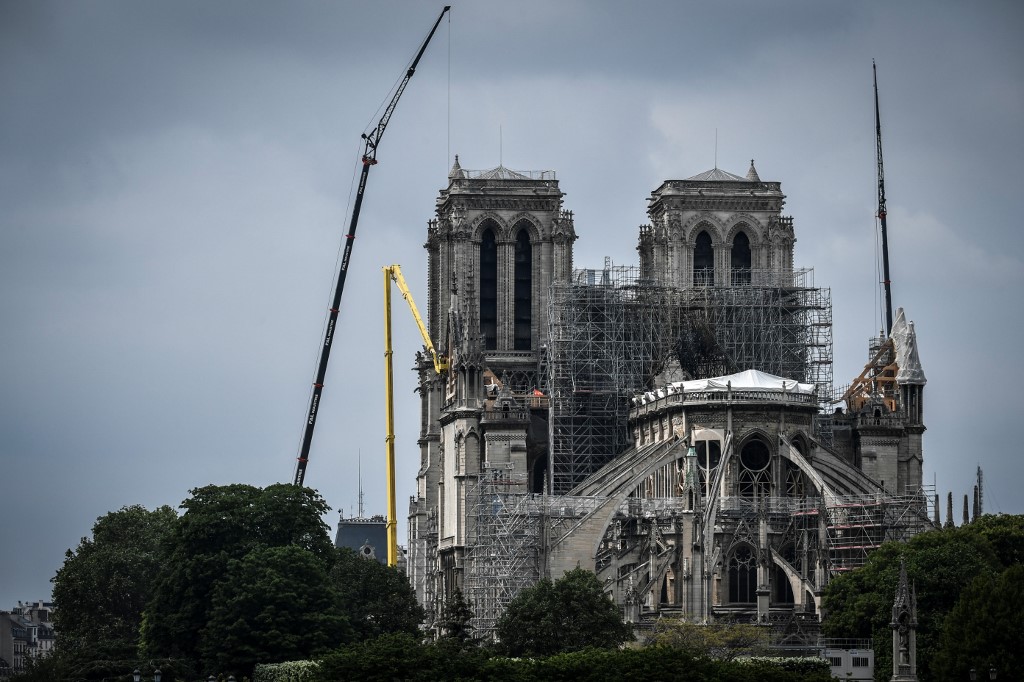Notre-Dame blaze: Parents urged to get children tested after lead pollution scare

French health authorities have advised parents living in central Paris with young children and pregnant women to get their lead levels tested after an abnormally high level was detected in a child in the area, which is likely linked to the blaze at Notre-Dame cathedral.
The fire that ravaged the Notre-Dame cathedral in Paris last month released lead particles that have settled in potentially dangerous amounts in areas surrounding the church - where many Parisians live, officials said last month.
Since then abnormally high levels of lead particles have been detected in a child living in Ile de la Cité, where Notre-Dame cathedral is located, and families with young children, as well as pregnant women in the area, have been urged by health authorities to get themselves tested.
The regional health authority responsible for monitoring the consequences of high amounts of lead after the Notre-Dame blaze, has triggered an "environmental investigation" to identify the cause or causes of the child's situation and verify that it is not related to any factors other than the fire.
READ ALSO:
-
'Don't mess with Notre-Dame' The Local's readers warn France
-
French Senate says Notre-Dame must be restored exactly how it was
 Photo: AFP
Photo: AFP
The child in question was found to have more than 50 micrograms of lead per litre of blood, an amount which "requires ensuring that the reasons for the exposure [to lead] have disappeared and regular monitoring of the child".
Fortunately at the moment the child does not need any other healthcare, said the health agency.
However, "as a precaution", families with children under 7 years old and pregnant women living on Ile de la Cité, are invited "to consult their doctor, who may prescribe a blood test for lead".
A screening consultation will also be set up by appointment at the Diagnostic Center at Hôtel-Dieu Hospital on Ile de la Cité from Tuesday.
Last month, analysis carried out since the April 15 blaze detected lead dust in "very significant" levels on some streets and pavements outside the cathedral, which remain off limits to the public.
Between 10-20 grammes of lead per kilogramme (g/kg) were detected in soil samples, compared with normal background levels of just 0.3 g/kg, according to a statement from the police and the ARS regional health service.
The fire destroyed the roof and steeple of the 850-year-old landmark, melting the large sheets of lead that covered an intricate wooden framework.
But officials said testing had not revealed any lingering lead pollution in the air, with all atmospheric analyses showing less than the legal limit of 0.25 microgrammes per cubic meter.
And outside the areas immediately surrounding the cathedral, "no sample on the Ile de la Cite or along the banks of the Seine indicated any lead levels in soils above the benchmark level," the statement said.
The Robin des Bois (Robin Hood) environmental NGO estimates the roof and steeple contained more than 300 tons of lead that melted in the blaze, and has urged officials to "decontaminate" the site before carrying out any reconstruction work.
 Photo: AFP
Cleaning urged
Officials said the lead posed little danger to residents, since only "repeated ingestions" of the toxic metal would be harmful to health.
There have been no reports of acute lead poisoning since the fire.
But the statement urged residents to clean all surfaces in their homes with wet cloths or wipes and to avoid the use of vacuum cleaners.
People should also wash their hands regularly and keep their fingernails cut short.
It also advised parents to wash toys often, since the faster metabolism in children under six makes any exposure to lead a particular risk.
Pregnant women should also take precautions to protect their babies from any exposure.
"Additional investigations are under way and testing will be carried out regularly to measure lead levels and ensure that health risks are kept under control," officials said.
The cathedral is expected to remain closed to visitors for years as workers clear away debris before embarking on an ambitious plan to restore the roof within five years.
Photo: AFP
Cleaning urged
Officials said the lead posed little danger to residents, since only "repeated ingestions" of the toxic metal would be harmful to health.
There have been no reports of acute lead poisoning since the fire.
But the statement urged residents to clean all surfaces in their homes with wet cloths or wipes and to avoid the use of vacuum cleaners.
People should also wash their hands regularly and keep their fingernails cut short.
It also advised parents to wash toys often, since the faster metabolism in children under six makes any exposure to lead a particular risk.
Pregnant women should also take precautions to protect their babies from any exposure.
"Additional investigations are under way and testing will be carried out regularly to measure lead levels and ensure that health risks are kept under control," officials said.
The cathedral is expected to remain closed to visitors for years as workers clear away debris before embarking on an ambitious plan to restore the roof within five years.
Comments
See Also
The fire that ravaged the Notre-Dame cathedral in Paris last month released lead particles that have settled in potentially dangerous amounts in areas surrounding the church - where many Parisians live, officials said last month.
Since then abnormally high levels of lead particles have been detected in a child living in Ile de la Cité, where Notre-Dame cathedral is located, and families with young children, as well as pregnant women in the area, have been urged by health authorities to get themselves tested.
The regional health authority responsible for monitoring the consequences of high amounts of lead after the Notre-Dame blaze, has triggered an "environmental investigation" to identify the cause or causes of the child's situation and verify that it is not related to any factors other than the fire.
READ ALSO:
- 'Don't mess with Notre-Dame' The Local's readers warn France
- French Senate says Notre-Dame must be restored exactly how it was
 Photo: AFP
Photo: AFP
The child in question was found to have more than 50 micrograms of lead per litre of blood, an amount which "requires ensuring that the reasons for the exposure [to lead] have disappeared and regular monitoring of the child".
Fortunately at the moment the child does not need any other healthcare, said the health agency.
However, "as a precaution", families with children under 7 years old and pregnant women living on Ile de la Cité, are invited "to consult their doctor, who may prescribe a blood test for lead".
A screening consultation will also be set up by appointment at the Diagnostic Center at Hôtel-Dieu Hospital on Ile de la Cité from Tuesday.
Last month, analysis carried out since the April 15 blaze detected lead dust in "very significant" levels on some streets and pavements outside the cathedral, which remain off limits to the public.
Between 10-20 grammes of lead per kilogramme (g/kg) were detected in soil samples, compared with normal background levels of just 0.3 g/kg, according to a statement from the police and the ARS regional health service.
The fire destroyed the roof and steeple of the 850-year-old landmark, melting the large sheets of lead that covered an intricate wooden framework.
But officials said testing had not revealed any lingering lead pollution in the air, with all atmospheric analyses showing less than the legal limit of 0.25 microgrammes per cubic meter.
And outside the areas immediately surrounding the cathedral, "no sample on the Ile de la Cite or along the banks of the Seine indicated any lead levels in soils above the benchmark level," the statement said.
The Robin des Bois (Robin Hood) environmental NGO estimates the roof and steeple contained more than 300 tons of lead that melted in the blaze, and has urged officials to "decontaminate" the site before carrying out any reconstruction work.
 Photo: AFP
Photo: AFP
Cleaning urged
Officials said the lead posed little danger to residents, since only "repeated ingestions" of the toxic metal would be harmful to health.
There have been no reports of acute lead poisoning since the fire.
But the statement urged residents to clean all surfaces in their homes with wet cloths or wipes and to avoid the use of vacuum cleaners.
People should also wash their hands regularly and keep their fingernails cut short.
It also advised parents to wash toys often, since the faster metabolism in children under six makes any exposure to lead a particular risk.
Pregnant women should also take precautions to protect their babies from any exposure.
"Additional investigations are under way and testing will be carried out regularly to measure lead levels and ensure that health risks are kept under control," officials said.
The cathedral is expected to remain closed to visitors for years as workers clear away debris before embarking on an ambitious plan to restore the roof within five years.
Join the conversation in our comments section below. Share your own views and experience and if you have a question or suggestion for our journalists then email us at [email protected].
Please keep comments civil, constructive and on topic – and make sure to read our terms of use before getting involved.
Please log in here to leave a comment.